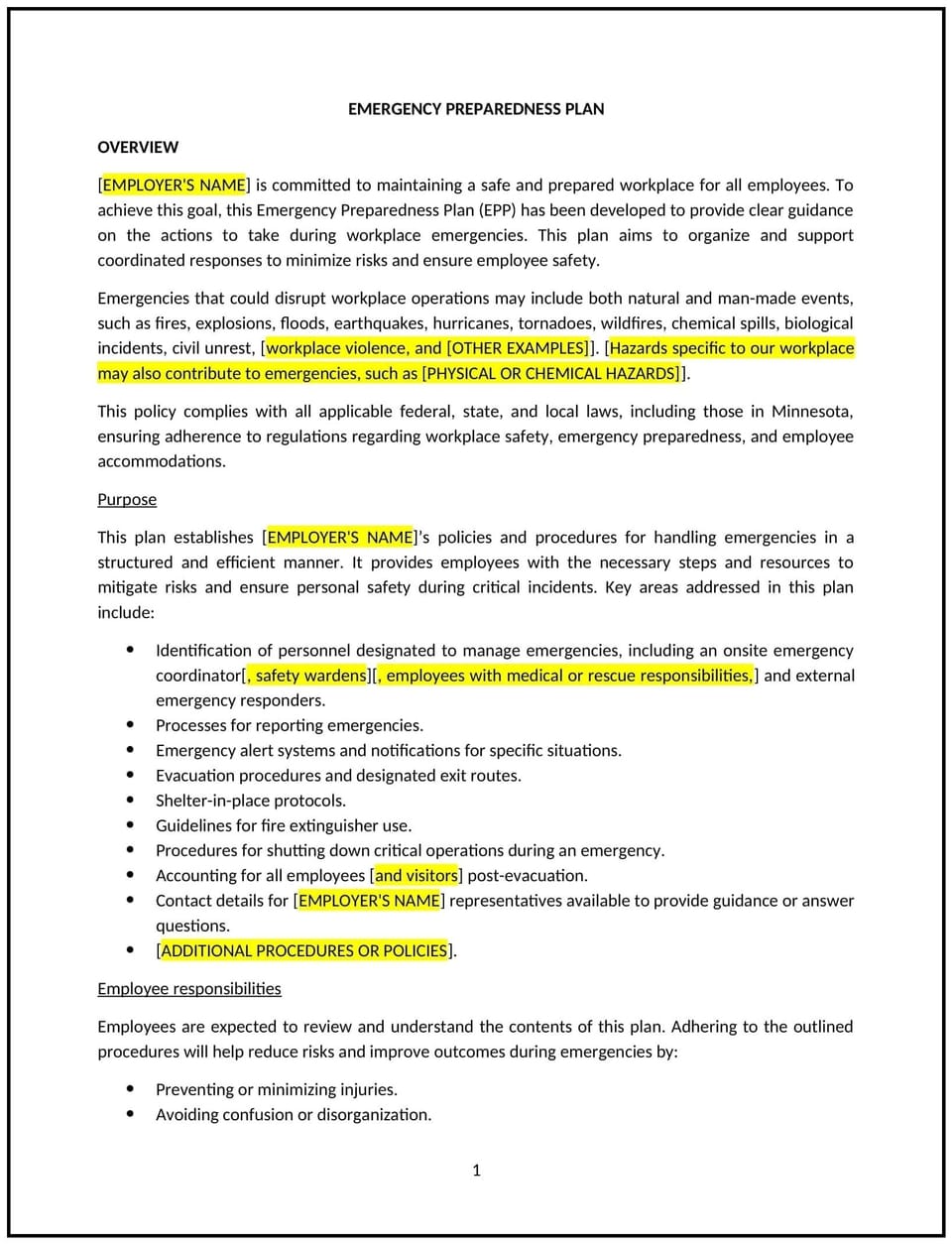Emergency preparedness plan (Minnesota): Free template

Emergency preparedness plan (Minnesota)
This emergency preparedness plan is designed to help Minnesota businesses develop and implement a comprehensive strategy to protect employees, assets, and operations in the event of a disaster or emergency. It outlines the roles, responsibilities, and procedures necessary to respond effectively to emergencies such as fires, natural disasters, health emergencies, and other critical incidents.
By implementing this plan, businesses can improve their resilience, minimize potential risks, and ensure the safety of their workforce during emergencies.
How to use this emergency preparedness plan (Minnesota)
- Identify potential emergencies: List the types of emergencies that could affect the business, such as severe weather (e.g., tornadoes, blizzards), fires, medical emergencies, or acts of violence.
- Define roles and responsibilities: Specify the responsibilities of key personnel during an emergency, including leadership, HR, safety officers, and external emergency responders.
- Establish emergency communication procedures: Develop clear procedures for notifying employees, customers, and stakeholders in the event of an emergency, including backup communication channels if primary systems fail.
- Create evacuation plans: Outline safe evacuation routes, exits, and assembly points for employees, and ensure that all staff are familiar with these procedures.
- Prepare for business continuity: Detail how essential operations will continue during or after an emergency, including remote work protocols, supply chain continuity, and critical function backups.
- Provide training and drills: Regularly train employees on emergency procedures, conduct drills, and review the plan to ensure readiness and efficiency in case of a real emergency.
Benefits of using an emergency preparedness plan (Minnesota)
Implementing this plan provides several advantages for Minnesota businesses:
- Enhances employee safety: Ensures that employees know what to do and where to go during an emergency, reducing the risk of injury or loss of life.
- Protects company assets: Helps safeguard physical assets, data, and business operations during emergencies, minimizing downtime and financial loss.
- Improves response times: By having a well-established plan, businesses can respond more effectively and quickly to emergencies, reducing confusion and improving outcomes.
- Strengthens community trust: Demonstrates to employees, customers, and stakeholders that the company is prepared for emergencies and values their safety and well-being.
- Reflects Minnesota-specific considerations: Adapts the plan to account for Minnesota’s unique weather patterns (e.g., snowstorms, tornadoes) and any state-specific emergency management regulations.
Tips for using this emergency preparedness plan (Minnesota)
- Communicate clearly: Ensure that all employees are familiar with the emergency preparedness plan, know their roles, and understand the evacuation routes and procedures.
- Regularly review and update the plan: Review the plan at least annually and whenever there are significant changes to operations, personnel, or Minnesota’s safety regulations.
- Conduct training and drills: Implement regular training and emergency drills to ensure that employees know how to respond to emergencies effectively and efficiently.
- Create a crisis communication plan: Develop a clear plan for communicating with employees, customers, and other stakeholders during and after an emergency to provide updates and manage expectations.
- Ensure business continuity: Establish strategies to keep critical business functions operational during emergencies, such as using remote work capabilities or having backup systems in place.
Q: What types of emergencies should be included in the plan?
A: Businesses should address a range of potential emergencies, such as natural disasters (e.g., tornadoes, snowstorms), fires, medical emergencies, workplace violence, and pandemics.
Q: Who is responsible for executing the emergency preparedness plan?
A: The plan should designate specific roles and responsibilities for key personnel, including emergency coordinators, safety officers, HR, and management. It’s essential that leadership is trained to guide employees during an emergency.
Q: How should businesses communicate during an emergency?
A: Businesses should establish communication channels, such as text messaging, email, or emergency notification systems, to alert employees about the situation. Ensure backup methods are in place if primary communication systems fail.
Q: How should employees be trained on emergency procedures?
A: Businesses should provide regular training, including on evacuation procedures, first aid, fire safety, and handling workplace violence. Regular drills should be conducted to ensure preparedness.
Q: What should businesses do to maintain continuity during an emergency?
A: Businesses should develop a continuity plan to maintain critical operations, such as shifting to remote work, using backup data systems, and ensuring that essential personnel are available during emergencies.
Q: How often should the emergency preparedness plan be reviewed and updated?
A: The plan should be reviewed at least once a year or whenever there are changes to the business’s operations, personnel, or regulations. Drills should also be conducted regularly to test the plan’s effectiveness.
Q: What should businesses do if an emergency occurs?
A: Businesses should activate their emergency preparedness plan immediately, ensuring that employees are safe, communication is maintained, and business operations are stabilized. Following the event, businesses should assess the response and make improvements where necessary.
This article contains general legal information and does not contain legal advice. Cobrief is not a law firm or a substitute for an attorney or law firm. The law is complex and changes often. For legal advice, please ask a lawyer.


